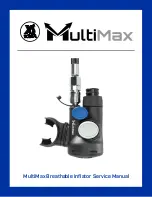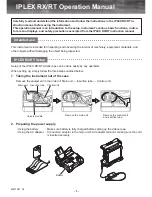
120 DF-760E
Sample Gas Preparation and Delivery
The oxygen sensor has a small pressure drop (0.2 to 0.5 psi), so relatively small changes in
inlet or outlet pressure causes dramatic changes in flow rate. Consequently, it is preferable
to vent the outlet to atmosphere so that outlet pressure remains constant, leaving inlet
pressure as the only variable to control.
8.3
Flow Rate Effects on Sensor Performance
8.3.1 Moisture
Assuming a leak-free system, flow rate changes will have minimal effects on the
performance of the moisture cell.
8.3.2 Oxygen
In a leak-free system, higher flow rates may cause O2 readings to increase by a few
percent of reading above the level that would be displayed if flow was within the
recommended 0.2 to 0.3 slpm range. Lower flow rates similarly cause O2 readings to
decrease by a few percent of reading.
The relative insensitivity to flow rate changes is the basis for the sample system leak
detection described below. It is recommended that the oxygen sensor, rather than the
moisture cell be used for leak-detection, due to the higher presence of oxygen in ambient
air as well as the faster response of the oxygen sensor to small changes in concentration.
The sensor output should be virtually constant for readings between 0.1 and 0.3 slpm.
Therefore, if O2 readings become higher at lower flows, then ambient O2 is leaking into
the sample system, or venting from a dead space (closed pocket with trapped higher O2
level gas) in the sample system. A higher flow rate dilutes the O2 entering the sample
system decreasing the reading. O2 readings in a leak free sample system should not go up
or down significantly with flow changes between 0.1 and 0.3 slpm.
8.3.3 Checking for Plumbing Leaks using Flow Rate Effects
Significant measurement error can be caused by leaks in the plumbing system. A simple
test of analyzer as well as overall system integrity can be performed to identify leaks.
Observe the analyzer oxygen readout at two flow levels: 0.2 and 1.5 slpm. Only a slight
increase, if any, in readout will occur in a tight system as the flow is increased. If leakage
in the plumbing system exists, then the increased flow results in a substantial decrease in
oxygen readout -- typically dropping by 25 to 50 percent.
As time passes, in a tight system, any sensitivity to flow should minimize as the system
purges of trapped oxygen.
When flow sensitivity is observed, check the external plumbing for leaks. Familiarity with
this process can result in the ability to actually estimate the distance from the analyzer to
the leak by the amount of time the change in flow rate effects the oxygen reading.
Содержание NanoTrace DF-760E
Страница 1: ...NanoTrace Dual Moisture Oxygen Analyzer DF 760E Instruction Manual...
Страница 4: ......
Страница 38: ......
Страница 44: ......
Страница 122: ......
Страница 128: ......
Страница 138: ......
Страница 142: ......
Страница 143: ...Service DF 760E 139...
Страница 144: ...140 DF 760E...
Страница 148: ......
Страница 166: ......
Страница 168: ......
Страница 171: ...DF 760E 167...
Страница 173: ...Appendix A User Menu Screens DF 760E 169 Page 65 Page 66 Page 67 14 2 Oxygen Menus Page 72 Page 74 Page 86 Page 87...
Страница 174: ...170 DF 760E Appendix A User Menu Screens Page 88 Page 91 Page 93 Page 97 Page 98 Page 99...
Страница 175: ...Appendix A User Menu Screens DF 760E 171 14 3 System Menus Page 102 Page 103 Page 103 Page 106 Page 108 Page 109...
Страница 176: ...172 DF 760E Appendix A User Menu Screens Page 110 Page 111 Page 113 Page 114 Page 115 Page 116...
















































